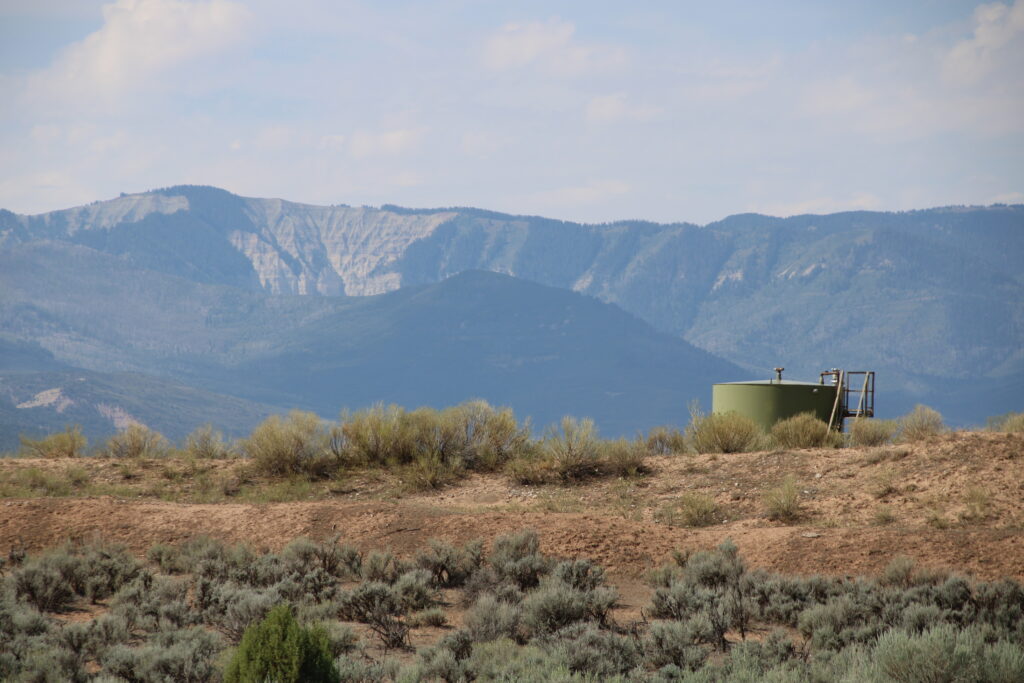|
Getting your Trinity Audio player ready...
|

In September, we wrapped up the third round this year of oil and gas facility surveys in Western Colorado’s Garfield County, conducted in partnership with Grand Valley Citizens Alliance (GVCA). Over the course of five different days between late May-early September, we conducted 59 optical gas imaging (OGI) surveys of 54 separate oil and gas facilities in Garfield County. Local community members then used OGI evidence of possible air quality compliance issues from 9 of those surveys to share their concerns with the Air Pollution Control Division (APCD).
The response from operators to this video evidence of pollution demonstrates:
- The power of community pressure in the fight for air quality improvements and,
- The frustration most frontline communities in Colorado experience because of a lack of action to address chronic pollution from the oil and gas industry
A Step Forward
Since 2021, our annual surveys of oil and gas facilities in Garfield County have included the Williams Parachute Creek gas plant a few miles outside the community of Parachute. Each survey of the site revealed significant pollution due to a malfunctioning flare. Earthworks and local community members have shared our evidence of pollution from the flare annually with APCD since 2021.
Still, year after year the pollution persisted (OGI videos from 2022 and 2023). Initially, the operator made adjustments in response to our concerns. However, after we continued to document pollution on return visits we received a cooler response, with the APCD even admitting that there was only so much that could be done to ensure such flares operate efficiently.

Earthworks OGI evidence of intermittent combustion in gas plant flare from May 2024. A steady plume of pollution is evident when the flare fails to combust properly
It is important to note that the census block containing both the gas plant and the community of Parachute is recognized as a disproportionately impacted community by the state of Colorado. Simply put, disproportionately impacted communities have a higher proportion of vulnerable populations exposed to environmental harms than other census blocks across the state. In this particular census block, almost half of the households are low-income and over a third of the population consists of people of color. Additionally, the burden from air toxics emissions associated with pollution sources like the gas plant is high enough to rank the census block in the 99th percentile of Colorado communities for that metric.
In other words, the population of this community has a higher exposure to air toxics than 99% of Colorado communities.This fact made inaction from the state on a chronic source of pollution in this community all the more disheartening.
It also means we were overjoyed this year when we learned, in response to a community member sharing more evidence of pollution from the flare with APCD, that the operator worked with the manufacturer of the flare to identify and address issues contributing to the excess emissions.
We can report that on a subsequent survey the flare appeared to be operating more efficiently than it has in any of our previous observations going back to 2021.
Chronic Frustration
This community effort was successful. The operator cited “concerns” from “previous years” as a motivating factor in taking these steps to address pollution. It was not an order by the state that achieved this outcome. Instead, it was a persistent drumbeat of pressure from Earthworks, GVCA, and community members.
This same dynamic has characterized another recent win by frontline communities against the oil and gas industry (Cultivando’s win in Commerce City) and it raises an important question: where is the state of Colorado when it should be standing up for communities?
While it is important to recognize success stories, we must also recognize the many instances where the lack of strong oversight means chronic pollution from oil and gas continues unabated.
Case in point:
A survey in August of an oil and gas wastewater treatment facility situated between the communities of Parachute and Rifle in Garfield County revealed significant uncontrolled pollution from large produced water storage tanks. A community member shared our observation with APCD and the operator responded by inspecting the site and finding that one of the tank hatches was dirty and unsealed. They reported cleaning and resetting the hatch in order to address the emissions.
A month later, in September, we returned to the site to ensure that the issue had been resolved and… We observed uncontrolled pollution from the same tank.

Earthworks OGI evidence of uncontrolled pollution escaping from a dirty, unsealed hatch on a produced water storage tank
We often work with communities to assume the burden of checking on the repairs that operators report to the state. We do this because the state rarely conducts follow up inspections of this nature themselves. Sometimes, as with the Parachute Creek gas plant, we can confirm that issues have hopefully been addressed. Unfortunately, that is not always the case.
In conclusion, holding oil and gas operators accountable for chronic pollution should not be the responsibility of frontline communities that are actively harmed by that pollution. Communities want rules that are enforced and stronger oversight of oil and gas activities. They want environmental justice prioritized. It is the responsibility of the state of Colorado to actually deliver.
